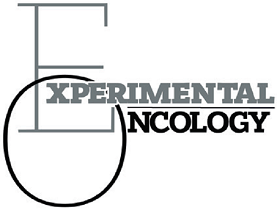ЕФЕКТИВНІСТЬ ДИСПЕРГОВАНОГО ВОЛОКНИСТОГО ВУГЛЕЦЕВОГО СОРБЕНТУ ПРИ ЛІКУВАННІ ЗЛОЯКІСНИХ ФУНГОЇДНИХ РАН
DOI:
https://doi.org/10.32471/exp-oncology.2312-8852.vol-43-no-4.16757Ключові слова:
адсорбційні перев’язувальні засоби, вуглецеві пов’язки, злоякісні фунгоїдні рани, хронічні рани, мікробіота рани, запах раниАнотація
Резюме. Мета: Вивчити вплив диспергованих волокнистих вуглецевих сорбентів (ДВВС) на стан злоякісних фунгоїдних ран у щурів з карциномою Герена з оцінкою якісних та кількісних особливостей бактеріальної мікрофлори ран та її взаємозв’язку з інтенсивністю запаху. Матеріали та методи: Дослідження виконано на самках щурів лінії Вістар, яким в верхню міжлопаткову ділянку підшкірно інокулювали штам клітин карциноми Герена T8. На 20-ту добу пухлини було інфіковано ін’єкцією суспензії S. aureus 8325-4. Через 24 год на рани в контрольній групі накладали марлеві пов’язки та ДВВС в експериментальній групі. Перев’язки проводили щодня. Стан ран оцінювали шляхом візуального контролю з фотомоніторингом, контролю запаху за вербальною рейтинговою шкалою та мікробіологічного аналізу якісних та кількісних характеристик мікробіоти рани. Результати: На 3-тю добу після початку перев’язок кількість стафілококів штаму S. aureus 8325-4 була значно більшою у ранах щурів контрольної групи, ніж експериментальної (5,14 ± 0,27 проти 3,43 ± 0,33 lg CFU/ml). Загальна кількість стафілококів у ранах під ДВВС статистично не відрізнялася від кількості S. aureus 8325-4, тоді як під марлевими пов’язками була на порядок більшою. На 10-ту добу загальна кількість стафілококів та S. aureus 8325-4 штаму зокрема, в ранах контрольних щурів залишалася стабільно великою, тоді як у експериментальних тварин була майже на 5 порядків нижчою і головним чином представлена S. aureus 8325-4. Загальна кількість аеробних та факультативно анаеробних мікроорганізмів у тварин цієї групи також була значно меншою. Більша різноманітність мікроорганізмів у ранах контрольних щурів, а також збільшення їх кількості супроводжувалося посиленням запаху рани від “помітного” до “сильного”. В експериментальній групі лише у однієї тварини спостерігалася тимчасова поява “ледве помітного” запаху. Висновок: Проведені дослідження продемонстрували здатність ДВВС помітно контролювати бактеріальну мікрофлору, а також неприємний запах злоякісних ран, які були змодельовані у щурів з карциномою Герена. Отримані результати можуть сприяти вирішенню проблеми підвищення якості паліативної допомоги хворим на злоякісні та інші хронічні рани.
Посилання
Fromantin I, Watson S, Baffie A, et al. A prospective, descriptive cohort study of malignant wound characteristics and wound care strategies in patients with breast cancer. Ostomy Wound Manage 2014; 60: 38–48. PMID: 24905356
Seaman S. Management of malignant fungating wounds in advanced cancer. Semin Oncol Nurs 2006; 22: 185–93. https://doi.org/10.1016/j.soncn.2006.04.006
Tsichlakidou A, Govina O, Vasilopoulos G, et al. Intervention for symptom management in patients with malignant fungating wounds — a systematic review J BUON 2019; 24: 1301–8. PMID: 31424694
Tandler S, Stephen-Haynes J. Fungating wounds: management and treatment options. Br J Nurs 2017; 22: S6–14. https://doi.org/10.12968/bjon.2017.26.12.S6
Lo SF, Hu WY. The physical, psychological, social, and spiritual impacts of malignant fungating wounds on cancer patient. Hu Li Za Zhi 2008; 55: 75–80 (in Chinese).
Bolton L. Evidence corner: evidence-based care for malignant wounds. Wounds 2016; 28: 214–6. PMID: 27377612
Tilley C, Lipson J, Ramos M. Palliative wound care for malignant fungating wounds: holistic considerations at end-of-life. Nurs Clin North Am 2016; 51: 513–31. https://doi.org/10.1016/j.cnur.2016.05.006
Wilson V. Assessment and management of fungating wounds: a review. Br J Community Nurs 2005; 10: S28–34. https://doi.org/10.12968/bjcn.2005.10.Sup1.17627
Adderley UJ, Holt IG. Topical agents and dressings for fungating wounds. Cochrane Database Syst Rev 2014; 5: CD003948. https://doi.org/10.1002/14651858.CD003948.pub3
Alexander S. Malignant fungating wounds: key symptoms and psychosocial. J Wound Care 2009; 18: 325–9. https://doi.org/10.12968/jowc.2009.18.8.43631
Winardi A, Irwan AMA Systematic review of topical treatment for controlling malignant wound odor. J Eur Wound Manag Assoc 2019; 20: 7–16. https://doi.org/10.35279/jewma201910.01
Gethin G, Grocott P, Probst S, Clarke E. Current practice in the management of wound odour: an international survey. Int J Nurs Stud 2014; 51: 865–74. https://doi.org/10.1016/j.ijnurstu.2013.10.013
Vardhan M, Flaminio Z, Sapru S, et al. The microbiome, malignant fungating wounds, and palliative care. Front Cell Infect Microbiol 2019; 9: 373. https://doi.org/10.3389/fcimb.2019.00373
Fromantin I, Seyer D, Watson S, et al. Bacterial floras and biofilms of malignant wounds associated with breast cancers. J Clin Microbiol 2013; 51: 3368–73. https://doi.org/10.1128/JCM.01277-13
Thuleau A, Dugay J, Dacremont C, et al. Volatile organic compounds of malignant breast cancer wounds: identification and odors. Wounds 2018; 30: 337–44. PMID: 30380523
Darwin ES, Thaler ER, Lev-Tov HA. Wound odor: current methods of treatment and need for objective measures. G Ital Dermatol Venereol. 2019; 154: 127–36. https://doi.org/10.23736/S0392-0488.18.05960-6
Eretskaya EV, Sakhno LA, Nikolaev VG. Application sorption: experience in clinical use and prospects of development. Biomater Artif Cells Immobilization Biotechnol 1991; 19: 129–45. https://doi.org/10.3109/10731199109117821
Sakhno LA, Nikolaev VG, Lozinskaya IA, et al. Basic studies of local adsorption in burn treatment. Biomater Artif Cells Immobilization Biotechnol 1991; 19: 111–28. https://doi.org/10.3109/10731199109117820
Nikolaev VG. Sakhno LA, Snezhkova EA, et al. Carbon adsorbents in oncology: achievements and perspectives. Exp Oncol 2011; 33: 2–8. PMID: 21423088
Nikolaev VG, Samsonov VA. Analysis of medical use of carbon adsorbents in China and additional possibilities in this field achieved in Ukraine. Artif Cells Nanomed Biotechnol 2014; 42: 1–5. https://doi.org/10.3109/21691401.2013.856017
Nikolaev VG. Sorption therapy with the use of activated carbons: effects on regeneration of organs and tissues. In: Chang TMS, ed. Hemoperfusion, Plasma Perfusion and Other Clinical Uses of General, Bispecific, Immune and Leukocyte Adsorbents. World Scientific, 2017: 221–43.
Shevchuk OO, Snezhkova EA, Bilous AG, et al. Detoxification as an addition to conventional therapy of acute radiation sickness and iatrogenic leukopenia. In: Ota Fuchs ed. Cells of the Immune System, Leucocyte Biology. London. Intechopen, 2019: 1–20.
Sakhno L, Pyatchanina T, Shapran A. Market research on commercialization of innovative products of pharmasector: adsorptive carbon dressing in M. Gawron-Lapuszek, Y. Suchukova eds. Innovative Approaches To Ensuring the Quality of Education, Scientific Research and Technological Processes. Katowice. House University of Technology, 2021: 1171–9.
Tamai N, Mugita Y, Ikeda M, Sanada H. The relationship between malignant wound status and pain in breast cancer patients. Eur J Oncol Nurs 2016; 24: 8–12. https://doi.org/10.1016/j.ejon.2016.05.004
##submission.downloads##
Опубліковано
Як цитувати
Номер
Розділ
Ліцензія
Авторське право (c) 2023 Експериментальна онкологія

Ця робота ліцензується відповідно до Creative Commons Attribution-NonCommercial 4.0 International License.



